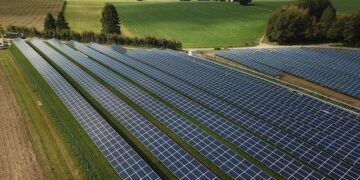Introduction:
In the heart of Washington State lies one of the most significant environmental challenges in the United States—Hanford, a former nuclear production site that now serves as a poignant reminder of the complexities surrounding hazardous waste management. The Hanford site is home to millions of gallons of radioactive tank waste, a legacy of the Cold War that still poses threats to public health and the environment. As local communities and environmental advocates voice their concerns, the Washington State Department of Ecology is stepping forward with a renewed commitment to address this critical issue. In this article, we explore the latest efforts, strategies, and technologies being employed to tackle Hanford’s tank waste, highlighting the importance of transparency, safety, and sustainability in the delicate balance between cleanup and ecological restoration.
Understanding the Complexity of Hanfords Tank Waste Management
Hanfords tank waste management represents a considerable challenge, not only due to the sheer volume of material involved but also its highly radioactive nature. Over the years, decades of nuclear activities have resulted in the accumulation of over 56 million gallons of hazardous waste stored in 177 underground tanks. These are primarily located on the Hanford Site in Washington State. Addressing this legacy involves navigating a complex array of scientific, environmental, and logistical considerations that require innovative engineering solutions. Among the critical steps in this management process are:
- Characterization: Understanding the physical and chemical properties of the waste.
- Stabilization: Keeping the waste in a controlled state to prevent leakage or vaporization.
- Treatment: Employing advanced technologies to minimize toxicity, volume, and hazard.
- Storage: Safe long-term storage solutions to contain the waste until it can be fully processed.
The task is further complicated by regulatory requirements and public scrutiny, making transparency and community engagement essential components of the management strategy. A robust oversight framework is in place, spearheaded by government agencies, ensuring that the remediation and waste management efforts adhere to safety standards and environmental protections. The collaboration between stakeholders such as federal and state agencies, tribal governments, and local communities is fundamental to the successful treatment of Hanford’s tank waste. Added to these complexities is the need for a cross-disciplinary approach that includes experts in chemistry, biology, engineering, and social sciences, allowing for a holistic understanding of the site’s intricate issues.
| Key Challenges | Potential Solutions |
|---|---|
| Leakage Risks | Advanced tank monitoring systems |
| High Radioactivity | Remote handling technologies |
| Public Concerns | Community outreach and education |
Innovative Solutions for Safe and Sustainable Treatment Methods
The management of Hanford’s tank waste presents one of the most significant environmental challenges in Washington State. Innovative approaches are essential to ensure that treatment methods not only safeguard public health but also protect the surrounding ecosystems. Current solutions under exploration include advanced technologies such as vitrification, which encapsulates radioactive waste in glass, and ion exchange, enabling the removal of contaminants from the waste stream. These alternatives promote a more sustainable approach by minimizing the generation of byproducts and reducing long-term storage concerns.
Furthermore, collaborative efforts involving state agencies, private sector partnerships, and academic institutions are crucial for the effectiveness of these innovations. Aspects to consider include:
- Continuous Research: Ongoing studies focus on developing more efficient extraction and neutralization methods.
- Community Involvement: Engaging local communities in decision-making to foster transparency and trust.
- Monitoring Technologies: Utilizing sensors and real-time data analytics to ensure safety standards are consistently met.
To facilitate understanding of these innovative solutions, a comparison of traditional versus modern treatment methods shows a clear trend towards sustainability:
| Method | Traditional Treatment | Innovative Approach |
|---|---|---|
| Waste Stability | Low | High |
| Long-term Environmental Impact | Significant | Minimized |
| Cost-Effectiveness | High | Improved |
Collaborative Approaches for Future Remediation Efforts in Washington State
As Washington State grapples with the ongoing challenges of managing Hanford’s tank waste, innovative, collaborative approaches among various stakeholders are essential for effective remediation efforts. Collaboration among government agencies, local communities, and research institutions ensures that different perspectives and expertise shape the decision-making process. Potential strategies may include:
- Public-Private Partnerships: Fostering collaboration between government and private sectors to allocate resources efficiently and improve technological advancements.
- Community Engagement: Actively involving local communities in discussions and decisions to ensure that remediation efforts reflect their concerns and priorities.
- Interagency Coordination: Streamlining efforts between agencies like the Washington State Department of Ecology and the U.S. Department of Energy to create cohesive and unified strategies.
- Research and Development: Investing in innovative waste treatment technologies through collaboration with universities and private research firms.
Critical to these collaborative endeavors is a transparent framework that establishes shared goals and accountability among stakeholders. A recent proposal outlines an action plan focused on the following key areas:
| Focus Area | Goals |
|---|---|
| Technology Assessment | Identify and evaluate new waste treatment technologies. |
| Stakeholder Outreach | Enhance communication and gather feedback from the public. |
| Funding Opportunities | Explore diverse funding sources for remediation projects. |
These initiatives demonstrate a commitment to not only tackling the complex issues surrounding Hanford’s tank waste but also ensuring that remediation efforts are comprehensive, effective, and responsive to the needs of all Washington residents.
The Way Forward
the ongoing efforts to address the challenges of Hanford’s tank waste represent a crucial intersection of environmental stewardship and public health in Washington State. The initiatives spearheaded by the Washington State Department of Ecology not only aim to remediate decades of nuclear waste but also to ensure the safety and well-being of surrounding communities and ecosystems. As strategies evolve and technologies advance, it remains essential for stakeholders and citizens alike to remain engaged in the conversation about sustainable solutions for one of the nation’s most complex waste management dilemmas. With continued transparency and collaboration, Washington is poised to lead the way in responsible and innovative waste treatment practices, setting a benchmark for similar challenges faced across the country. As we move forward, the importance of a comprehensive approach to managing Hanford’s legacy cannot be overstated—it’s a commitment to both our present and future.





























